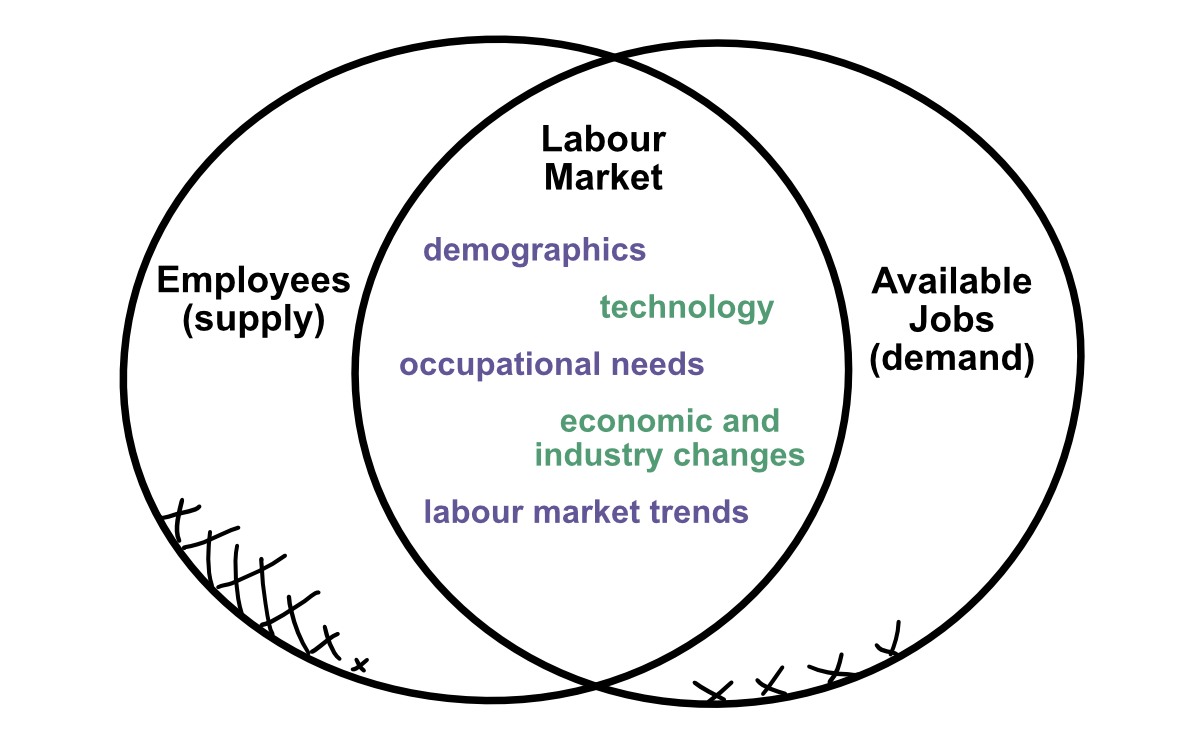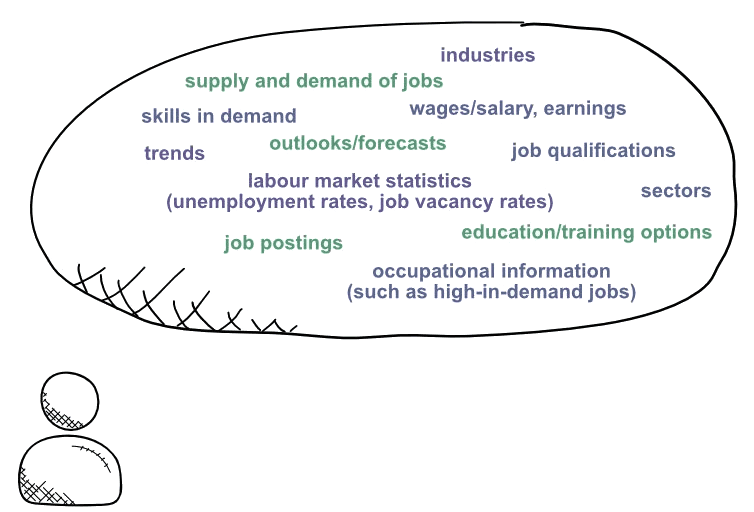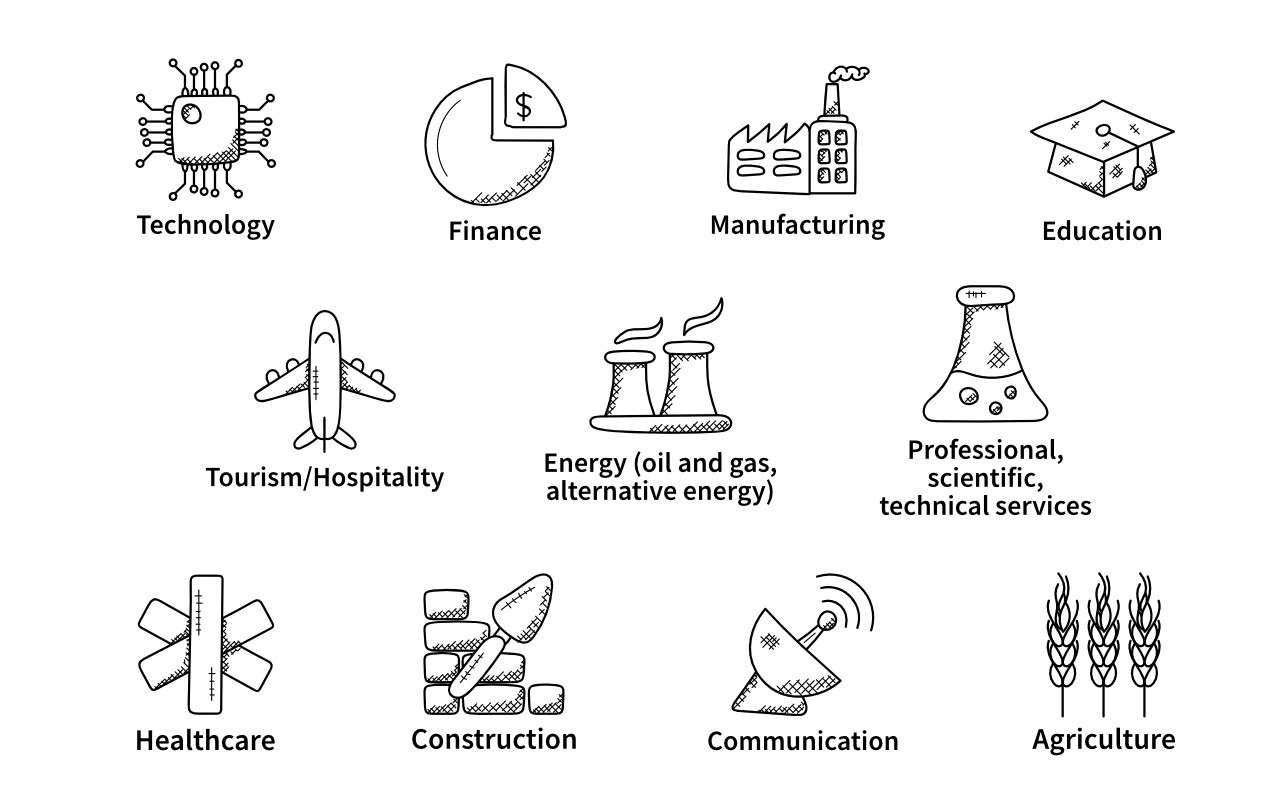✨ Activity: External Influences
| Site: | RRU Open Educational Resources |
| Course: | Career Management Resources for Professionals |
| Book: | ✨ Activity: External Influences |
| Printed by: | Guest user |
| Date: | Sunday, 7 December 2025, 2:57 AM |
Description
Introduction
This is a multi-page guide to help you identify external influences. You can navigate through the pages using the Table of Contents on the right of your screen (you may need to scroll down to the bottom if you are on a mobile device). You can also advance through the pages using the 'next' and 'previous' buttons at the top and bottom of each page.
Labour market information (LMI) is: comprised of knowledge, facts, data and other relevant institutional information which pertains to the supply and demand of labour. In other words, labour market information is any information that could support the decisions Canadians make in the world of work and in terms of learning, education and training (Labour Market Information Council, 2018).
This worksheet has five components:
- Labour Market Information (LMI)
- Industries
- Trends
- Occupational information
- External factors
This worksheet provides an overview of LMI and specific areas, industries, trends, and occupational information including websites as examples in each of these areas. Then, you can personalize a LMI search like you would with an academic Boolean search, however using LMI terms instead.
Examples of LMI searches using Boolean expressions:
Search terms: business communication + labour market + job trends + 2024
Results from this search:
- Labour Market Outlook: Spring 2024 - CIPD
- Analysis of Labour Challenges in Canada, fourth quarter of 2024 - Statistics Canada
- 6 work and workplace trends to watch in 2024 The World Economic Forum
Search terms: leadership + future labour market trends 2024
Results from this search:
- 20 Labor Market Trends To Watch For In 2024 - Forbes
- 6 Workplace Trends Leaders Should Watch in 2024 - Gallup
- 2024 Labour Market Review: Challenges, Trends, and Policy Solutions for Canada - Global
Personalize your searches by adding your program, current sector, industry, and/or occupation, or industries and occupations that you are interested in.
Labour market research depends on recognizing emerging terms and important skills in different industries. To do this research well, it's important to connect with professionals in the fields you're interested in and learn from their experiences. You can learn more about how to build these connections in the Discovering Connections Unit.
1. Labour Market Information (LMI)
Career management includes career planning, which involves researching the labour market—the intersection of employee supply and employer demand. This market is shaped by factors like demographics, technology, occupational needs, economic shifts, industry changes, and labour trends. (ALIS, 2001-2021).

An example of a demographic factor influencing the labour market could resemble a scenario like this,
- as the aging population increases,
- the need for healthcare services increases,
- healthcare products and services increases, and
- the demand for workers in this field increases,
Or
- as the world slowly adopts solar energy,
- the need for fossil fuels decreases,
- demand for oil and gas equipment and services decreases, and
- the demand for workers in this field decreases.
LMI is all around us and is reliant on our global economy which can include many aspects:

LMI Important Points
Sources: LMI can be found on the web, in print, and by talking with people.
Validity: LMI can be quickly outdated. It is important to be discerning about the validity of the information. You can use the CRAAP Test: Currency, Relevance, Authority, Accuracy, and Purpose (CSU, Chico, 2010) to analyze your sources. Be mindful of the potential unconscious or conscious bias in your search terms. Continue to ask yourself if the source is reliable and trustworthy.
Industries: The decline of certain industries often creates new opportunities. For example, the rise of online banking, financial chatbots, and AI contributed to the decline of bank tellers, supervisors, and financial planners. These shifts illustrate the importance of opportunity awareness—when you see an industry fading, ask yourself: what new opportunities could emerge?
Hidden Job Market: This is the job market where employers do not post jobs publicly. Rather, the jobs are filled internally, by referral, or word of mouth. When you develop your community/network (covered in the Discovering Connections unit) you will become aware of more options.
Forecasting: Anticipating skills disruptions, such as a decline in a skillset, an industry, or an occupation, allows you to be proactive in gaining new skills and experiences that keep you competitive in your chosen career path.
LMI Scenarios
LMI can be valuable for career management and life decision-making in a number of ways.
Labour markets, people, and careers are dynamic and change.
- Sometimes people will commit to a direction despite a limited career opportunities because they are passionate about a specific career path, and land a job right after they complete their degree.
- Sometimes people pursue an occupation that is in high demand, land a job and do not feel fulfilled.
- Some people pursue a high paying occupation, land a job and love it.
While there are never any guarantees, conducting LMI research is a prudent and valuable action. Your decision-making will be more informed and you will move forward with your eyes open.
Here are a few scenario examples:
Scenario one
Julia is a single parent and requires an occupation with flexibility. Julia conducts occupational and labour market information research and learns that she can transition within the communications field as there is flexibility and many possibilities to work from home.
 Photo by Ketut Subiyanto from Pexels
Photo by Ketut Subiyanto from PexelsScenario two
Samson has been working in management in the financial industry for a number of years. He is passionate about leading others, however, he has determined that he wants to work in the non-profit sector because of his value for people. After conducting research on trends and meeting with executive directors for information meetings, he is strongly considering a transition to social enterprise.
 Photo by Jopwell from Pexels
Photo by Jopwell from PexelsScenario three
Rian is a newcomer to Canada and was interested in social justice issues prior to his move. Rian was encouraged to volunteer as a way to become settled in Canada, research occupations in this field, and acquaint himself with the labour market. He contacted a local volunteer organization about opportunities in the social justice area. In addition, he searched for social justice organizations to help with a small side project as a volunteer.
 Photo by RODNAE Productions from Pexels
Photo by RODNAE Productions from PexelsLMI Activity
Web Quest
Conduct a Boolean search and find at least three relevant sources to your situation--use the CRAAP Test to discern your sources. Then jot your answers to these questions, either in the downloadable External Influences Worksheet, or in your own journal:
- From the information you found, what could inform your next steps?
- How could you use these sites to your advantage for future use?
- Did you discover any surprising information?
Here are some general resources to get started:
2. Industries
"An industry is a group of companies that are related based on their primary business activities." - Investopedia
Staying connected to your industry community/network is effective career management to
- Learn about emerging trends and opportunities.
- Gain industry knowledge through professional development, conferences, and/or webinars.
- Understand how to contribute to your industry.
For those in career transition, choosing an industry of interest can seem daunting. Many career skills are applicable across industries—from hospitality to education, to healthcare. It is important to understand what external factors may create challenges to transitioning your skills into a new industry.
Activity

Go online and investigate an industry of interest (if you are established in an industry, search for another), an emerging industry, and a declining industry. You can choose from the list below or an industry of your choice.
Jot your answers to these questions in your External Influences Worksheet, or in your journal.
- What challenges do these industries face?
- What information did you learn that could influence your career path?
- If you are established in your career and industry, how do you keep a pulse on your industry?
Here are some ideas for industries to investigate, or choose your own:

These sites will be helpful in your investigation:
- Work BC Industry and Sector Outlooks
- Government of Canada Canadian Industry Statistics
- Hint: Search your home province, territory, or destination for information on your geographic area.
3. Trends
"A trend is a general direction into which something is changing, developing, or veering toward. The term may also mean a fashion or craze, i.e., a fad. The verb ‘to trend’ means to develop or change in a general direction." — Market Business News
Trends are everywhere—some last, others fade—spanning business, fashion, culture, and more.
From a career perspective, how can you track trends in your field to stay informed about growth, changes, or decline?
Activity
Watch this video to consider some top trends.
Top 20 Trends in 2021 Forecast (9:40)
Jot your answers to these questions in the External Influences Worksheet, or in your own journal:
- What trends have directly or indirectly impacted you personally and professionally?
- What trends can you foresee influencing your future?
- How might you take a course of action to stay ahead of the game?
4. Occupational Information
Occupation is defined as "A collection of jobs sufficiently similar in the work performed to be grouped under a common label" - LMiC
Occupational information is helpful during career transition to explore and navigate the range occupational information you are unfamiliar with.
Occupational profiles and job postings are a great starting point and can include:
- wages/salaries,
- duties,
- future outlook,
- industry required credentials, and
- educational and skill requirements.
However, occupations are changing at such a rapid pace that some emerging occupational profiles may not event exist yet!
The most direct way to obtain current information such as what a typical day looks like or future trends, is talking with someone who works in this occupation through an information meeting.
Activity
Review an occupational profile of interest from two different sites.
Jot your answers to these questions in the External Influences Worksheet, or in your own journal:
- What are the similarities between the occupational profiles from each site, and
- what are the differences between the occupational profiles?
Occupational Profile Sites
5. External Factors
Activity:
Identify the factors that are priorities in your life. You will find examples of factors in the External Influences Worksheet such as lifestyle, financial earnings, work, and community involvement.
Circle or jot your important external factors in the External Influences Worksheet, or in your own journal. Some suggestions can be found on the worksheet to get you started.
Next, continue on to Summary: External Influences
